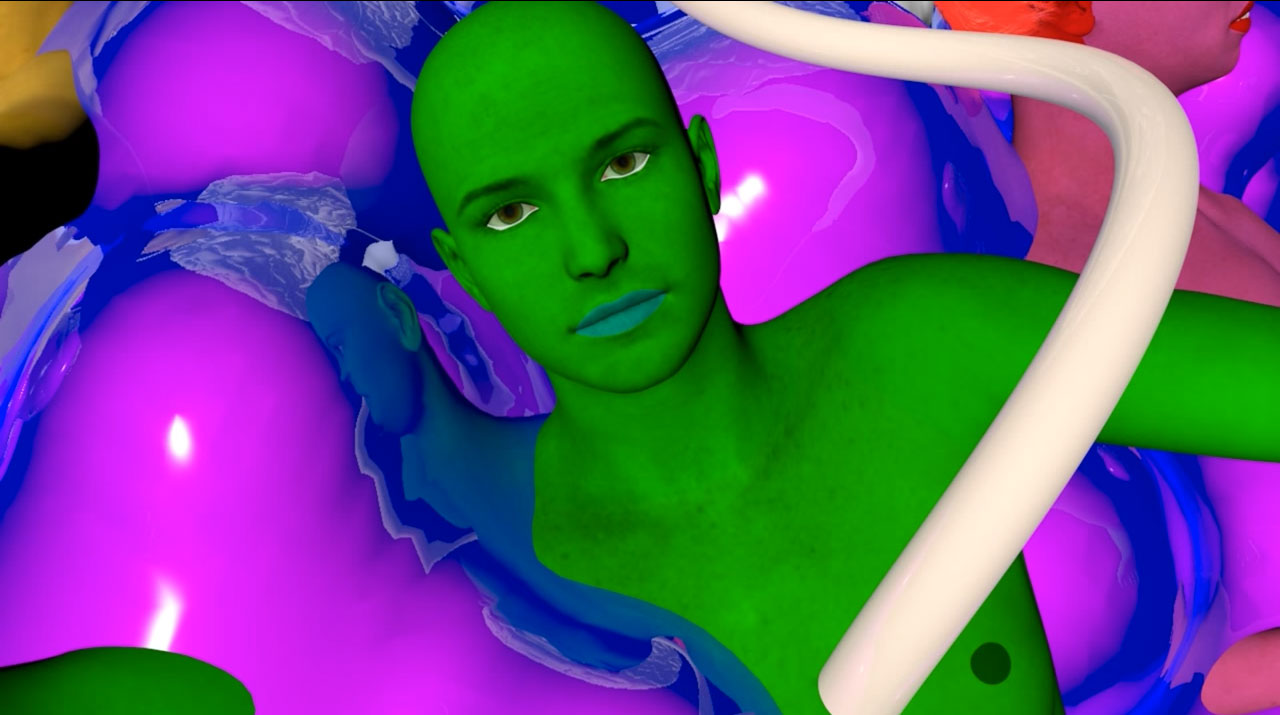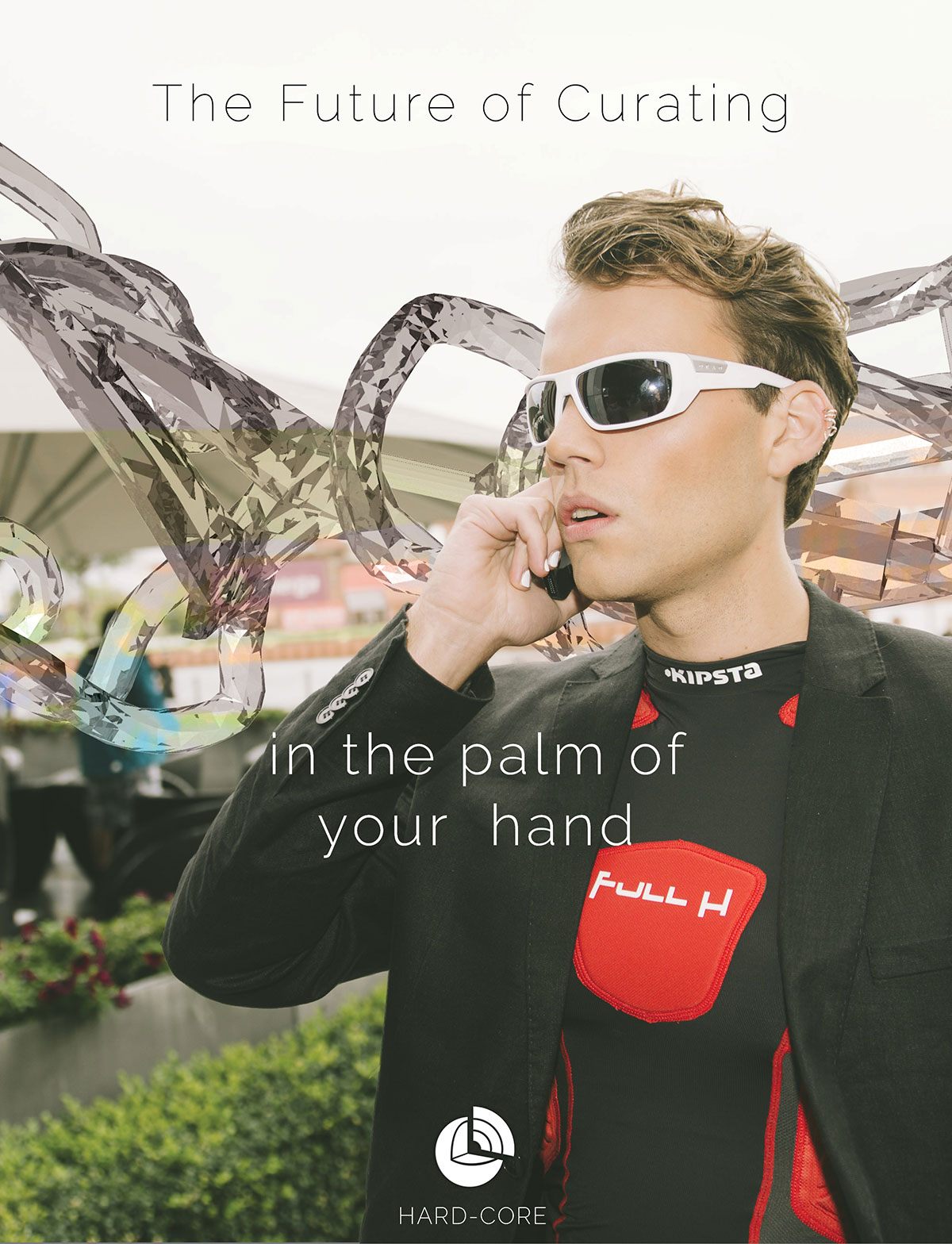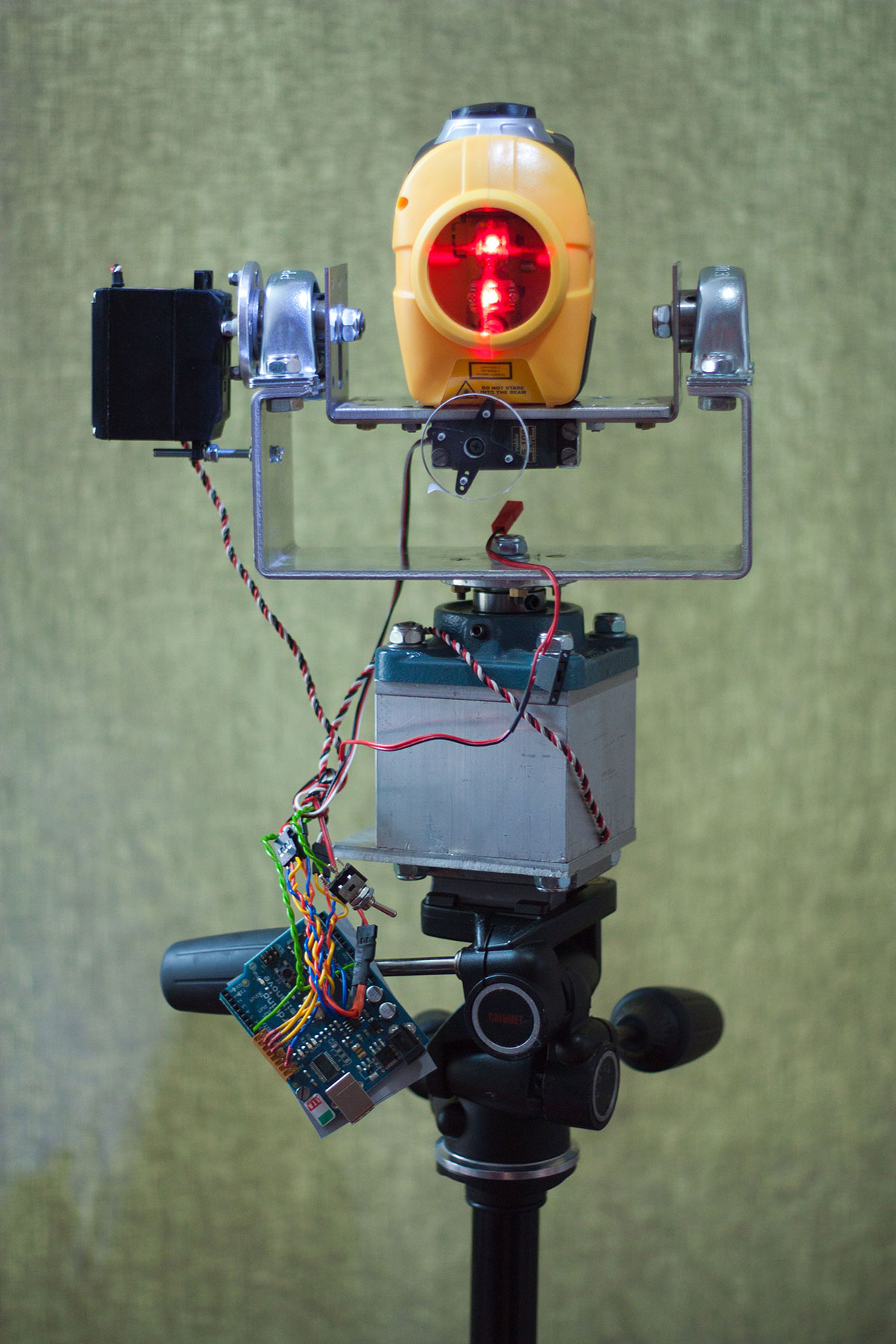
HARD-CORE AND ASAHI 4.0 — The Future of Robotic Curating
The next generation of robotic curation — ASAHI 4.0 — is projected to come out in 2017. A machine conceived by HARD-CORE, ASAHI is able to automate what used to be the human skill of curating art exhibitions. Past models of ASAHI have used the contemporary technology of randomizing algorithms to successfully organize the position of artworks within space. In so doing it has enabled the machine to free aesthetics from the many pitfalls of contemporary curation, including those of subjective choice, arbitrary protocol, and especially of taste. The exclusion of which has allowed artists to show works within a truly neutral spatial arrangement. Thereby fulfilling what the white cube of the gallery space was to have promised the artist as a condition to best enjoy art.

A word originating from Latin, the concept of curation is derived from „caring for“. It refers to the way that the curator „cares“ for projects that had been commissioned for the public good. In Roman times it would include managerial duties ranging from the construction of aqueducts, to the maintenance of libraries. Today the word has undergone a change in meaning so as to be understood less as a public servant and more as a free agent. One that implies a position of authority due to the curator’s responsibility in negotiating between the elements that form a ruling order, including the influences of popular opinion, financial capital, and the effects of political control. It is a position acquired through the curator’s perceived status as „impartial“ professional whose decisions relies exclusively on taste. Which may be responsible for a shifting power dynamic between the artist and the curator, wherein the artist’s visibility has come to rely on the curator’s capacity in negotiating between such elements.

Taste however, is now as it has been in the past, embedded in class-driven social structures. Once overtly controlled, the banal realities that now contribute to the validation of taste include the now high cost of art education, the lack of monetary return for such an investment, the leisure time necessary to consume cultural products, and perhaps most importantly — the sentimental landscape required to renounce participation in the production of tangible commodities. But all these consideration are perhaps secondary to the abstract levels implied by aesthetic choice. A level in which taste is given the illusion of being preordained rather than being the result of subjective choice. As would be the case in the example of a curator who remains in a subordinate position towards those elements with which the curator had negotiated to achieve aesthetic aims. This would, as a result of a structural logic, lead the curator to produce a visual code that may in reality reflect the values of those to whom the curator is indebted. It is process by which to validate aesthetic choice that stands in diametrical opposition to that of the artist— who may yet have subversive aims when reproducing the social norms of a ruling order. Aims at which the artist may often achieve on account of the artist’s formal ability to camouflage work as — while still acting against — a prevailing order.
In HARD-CORE’s case, their aesthetic reference in creating ASAHI has been that of product development. Indicating a certain indifference towards the working of the machine, this style aligns them with the Futurists of roughly a hundred years ago. Not being so interested in mechanics, the Futurists were preoccupied in the look and feel of the then contemporary innovation of the automobile. A sentiment reflecting the zeitgeist of technological innovation, a joy towards the newness of a product, and the pleasure evoked by corporate branding, these are elements that together hint at their complimentary underbelly of their eventual datedness. Which in capitalist logic works to accelerate their pace of redundancy.

In terms of product development, ASAHI has however evolved through, and alongside, simple analogue systems and computational processes. Circular Projection is an example of an analogue feedback loop wherein an artist gives a neighbouring colleague the power to curate the artist’s work. This colleague is then curated by a neighbour, and so forth to the next neighbour, until a closed circle is formed. Co-Re-Curation runs on the simple logic of a remix, where the same set of works are re-curated by different groups of 2 to 3 „curators“. This group is then asked to rationalize their arrangement in the form of a statement. This necessity of the statement further emphasizes a hierarchy that had been produced by inviting multiple curators to do the same thing several times. It effectively stages the competitive dynamics of demand-and-supply that has traditionally led labourers such as artists to receive ever-lower returns for the same amount of work. Then there is Toolbox nr. 1 — a webpage that provides algorithms by which to randomize the components that constitute the curation of an exhibition. Those elements include the name and opening hours of an exhibition, the wall colour, light condition and shape of the exhibition space, as well as including randomizers to decide the location and height of the artworks therein.
The problem with each of these systems is that it is still up to humans to execute the processes that they dictate, just as it had been up to them to volunteer their participation in the first place. This may explain why HARD-CORE has constructed ASAHI as a robot that is the personification of such systems. This machine continues to deal with processes by which to organize art, this time as an autonomous unit capable of curating an exhibition.
This first generation of curational robotics — ASAHI 1.0 — is a simple machine that consists of a camera mounted in the space of the exhibition. It uses randomizing algorithms to selects the camera’s position and point of depth. The artwork’s position can thereby be deciphered by following the camera’s trajectory, and in using its point of depth to determine a position from within that trajectory. In the next version of ASAHI 2.0, the camera is replaced by a laser that creates a visible trajectory in space, which allows humans to make a more accurate reading of ASAHI’s decisions. ASAHI 2.0 also has the additional feature of a randomizer that lets the robot select one from within several positions along the laser’s trajectory. ASAHI 2.1 represents yet another new step towards robotic independence. Now capable of interacting with Toolbox nr°1, it extracts data from it to decide a position in which to place itself when making its curatorial choices. The next generation of ASAHI 3.0 solves the issue of robotic autonomy differently. This third generation is a mobile unit that navigates an exhibition space on four wheels. Using the same principle of randomization, it is now capable of moving autonomously to select the location of artworks.
Each of these models is represented by sequential numbers to indicate its levels of autonomy from human intervention. They indicate new generations of technology — a concept built on biological evolution according to which, each species attains maximum potential and minimum waste by being in constant competition within its own, as well as other species. Product development therefore forms generations to the extent that it is driven to attain maximum efficiency by being in competition within their own line, as well as with other brands.
This concept of the generation changes slightly when applied to the realm of culture. It is here that art history speaks of the „progression“ of aesthetic values thanks to a series of competitive trans-generational tensions. This is a feedback mechanism where each generation competes to occupy the position of the avant-garde. Wherein the younger generation will always win on account of how each rear-guard had once been the avant-garde to those who came before. Evoking an evolutionary movement, it is informed by the psychological tension of the Oedipal drive in which the rear-guard takes the position of parent-figures who is under psychological pressure to reproduce their own ideology. All the time knowing that by doing so, they are sowing the seed of those that will eventually supplant them. Meanwhile the younger generation is under a complimentary set of tensions to soak in knowledge from their parent-figures while simultaneously aiming to outdo them. Eventually they will be forced to choose between their own mediocrity or the trauma involved in performing a symbolic murder of their father.
However, even if subliminally affected by an Oedipal tension, the common understanding of a „generation“ is far more neutral. Referring instead to a cultural unit of individuals that had been born at approximately the same time, they are defined by the moods, styles, and technology of a given era, particularly in relation to sentimental influences from their formative years. The current generation of millennials tend for example, to be defined by their relationship with technology. Not having known of a reality before the internet became prevalent, it forms the contours of what this generation understands to be reality. An example of the formal repercussions of this influence lies in the aesthetics of the post-digital, while the sentimental effects may indicate a shift towards sincerity. Built on the psychology of transparency, it is a sentiment that may be the result of overstimulation and overexposure to information in the age of the internet. In so doing, it produces a contradiction similar to the turning of a glass. First it is transparent. Then it is grey, verging on black. Eventually it will reflect the light source back towards the one who holds the glass. Likewise, the manipulation of sincerity may form its own inversion.
A case in point lies in HARD-CORE name — a cultural references that brings to mind not just pornography, but specifically hard pornography. A genre particular to competitive capitalism, it is placed higher on the hierarchy of spectator-driven exploitation for its capacity to raise the stakes of its transgression. The logic of the name therefore seems to refer to their willingness to take part in an increasing pace of self-exploitation so as to compete within the attention economy, as well as in the real economy. Yet its members propose to be oblivious to this reference when choosing HARD-CORE as their name. In a tactic that seems to be staging their own innocence, HARD-CORE’s members seem to imply that to even know the reference to pornography is to be complicit with the genre. What reason, after all, do we have for admitting to know about this fringe economy that is supposedly invincible to those not actively seeking it out?
The actual reference in HARD-CORE ‘s name is so innocent that it verges on the comical. Alluding to a graph from an elementary class in geology, HARD-CORE’s name refers the mass inside the planet’s core. This mass has a magnetic charge that works as an allegory to refer to HARD-CORE’s methodology. It describes a strategy by which HARD-CORE seeks to attract other artists by constructing the necessary autonomy that would allow multiple agents to coexist within the same, loosely defined orbit of a HARD-CORE project.
The creation of ASAHI holds this same strategic sense of innocence as had gone in constructing HARD-CORE’s name. Because the creation of an algorithm to obtain objective methods of curation may actually seem self-evident in the current mood of technological advancement. Were it not for the fact that the machine is designed to address and subvert an underlying hierarchy between curator and artist when the second is working to exclude the former. The construction of the machine thereby introduces an element of comedy derived from the apparent sincerity of intention in creating this technological advancement. It is a strategic denial of negativity in which HARD-CORE uses to take advantage of the fact that we are not supposed to openly admit to power relations that are inherent to the exhibition of art. Which is why when the curator robot appears, no one seems to be able to say anything about its subversion. Because on an official level, there had been none.
In continuing its work within the field of robotic curation, HARD-CORE has developed a model that will go further than previous generations in subverting embedded hierarchies in the field of aesthetics. No longer limiting itself to merely choosing the position of objects in the space of an exhibition, ASAHI 4.0 is capable of deciding which artist will show in which exhibition venue. It will do this by using a webpage (www.asahi4.com) to which artist and exhibitions spaces may inscribe themselves. Continuing to use its randomizing algorithms, ASAHI 4.0 uses this input to create objectively random configurations of artists, artworks and exhibition venues.
It is here where ASAHI 4.0 evokes a complex irony: In creating radically new visual ecologies that no longer rely on pre-existing conformities, ASAHI allows the audience to direct its attention more fully towards the ability of each artist’s work to compete with other objects on display. Like any game, it is the organizational structure of neutrality that reproduces these conditions of competition. But the complexity of such structures lies in how they simultaneously evoke its opposing movement by negating pre-existing hierarchies that had been the result of past competition. The charm of the project, however, doesn’t lie in the irony of this paradoxical movement between artificial equality and competitive quality. Rather it lies in the uncanny optimism of a strategy that lies in building an autonomous agent of critique. As robots don’t understand irony, HARD-CORE uses sincerity to convince the machine to go against its nature to dissuade existing hierarchies instead of supporting them.
Go to www.asahi4.com to apply.
Geirþrúður Finnbogadóttir Hjörvar
Images: courtesy of Hardcore
